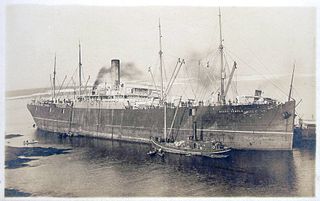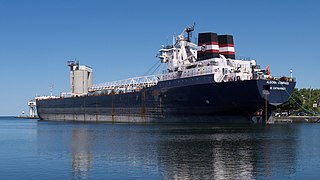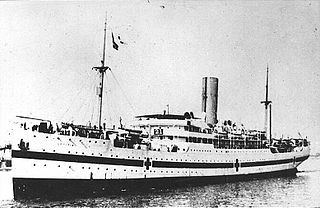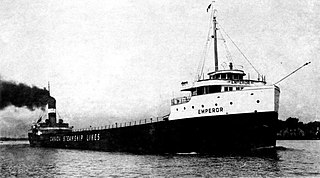
Mount Temple was a passenger cargo steamship built in 1901 by Armstrong Whitworth & Co. of Newcastle for Elder, Dempster Shipping of Liverpool to operate as part of their Beaver Line. The ship was shortly afterwards acquired by Canadian Pacific Lines and was one of the first vessels to respond to the distress signals of the RMS Titanic in 1912.

CCGS Simcoe was a Canadian Coast Guard buoy tender and light icebreaker. The second vessel of the name in Canadian government service, Simcoe was in service from 1962 to 2007 based out of the Coast Guard base at Prescott, Ontario working the Great Lakes and Saint Lawrence Seaway. In 2008 the ship was sold to commercial interests.

The SS Regina was a cargo ship built for the Merchant Mutual Line and home ported in Montreal, Quebec. Named after Regina, Saskatchewan, Regina had a tonnage of 1,956 gross register tons (GRT) and a crew of 32.

SM UB-6 was a German Type UB I submarine or U-boat in the German Imperial Navy during World War I. The submarine was interned after running aground in neutral Dutch waters, and was scuttled by her crew at Hellevoetsluis.
Quebecois was a lake freighter that served the Great Lakes, operating between ports in the United States and Canada. The vessel was launched in 1962 by Canadian Vickers Ltd of Montreal, Quebec, Canada. Used to carry grain and ore, Quebecois was built to the maximum dimensions allowed on the Saint Lawrence Seaway. The vessel entered service in 1963 and in 2012, the ship's named was altered to Algoma Quebecois. The ship was broken up for scrap at Port Colborne, Ontario, Canada in 2013.

Sauniere was a self-unloading bulk carrier operated by Algoma Central. Laid down as Bulknes, before launching the vessel's name was changed to Brooknes. The ship was constructed and completed in 1970 and was initially owned by the Swedish company Kristian Jebsens Rederi A/S. In 1974, Algoma Central purchased the vessel, registered the ship in West Germany and renamed it Algosea. The ship was sent to Swan Hunter in England to be lengthened. Emerging in 1976, Algosea sailed for Canada for conversion to a self-unloading bulk carrier at Herb Fraser and Associates in Port Colborne, Ontario. Algosea, which transported road salt between ports in the Gulf of St. Lawrence, Saint Lawrence Seaway and Great Lakes suffered three collisions and two groundings during its career. The vessel was renamed Sauniere in 1982 and continued in service until 2009 when the bulk carrier was sold for scrap and broken up in Turkey in 2010.

SS Brulin was a lake freighter that worked the North American Great Lakes routes from 1924 to 1960. She was renamed Outarde in 1939, and James J. Buckler in 1960, shortly before she ran aground and sank during salvage operations. Brulin was built by Palmers Shipbuilding and Iron Company, Hebburn-on-Tyne and launched on 31 July 1924, for the Montreal Forwarding Company. She was built to the maximum dimensions of the canal locks that preceded the St Lawrence Seaway.

Algoma Compass, formerly Roger M. Kyes and Adam E. Cornelius, is a self-unloading bulk carrier built in Toledo, Ohio in 1973 for the American Steamship Company. The bulk carrier carried bulk cargoes throughout the Great Lakes and St. Lawrence Seaway. The vessel has earned a reputation as a "hard luck" ship, experiencing mechanical failures and groundings. In 2018, the ship was acquired by Algoma Central and put in service as Algoma Compass.

Tundra is a bulk carrier. She was launched in 2009. The maritime site boatnerd reports she is operated by Navarone SA of Limassol, Cyprus, and leased to Canfornav Incorporated of Montreal, the Canadian Forest Navigation Group. Marine Link however reports that she is owned by Canfornav.

HMHS Letitia was a British hospital ship that ran aground at Portuguese Cove in Halifax Harbour, Canada on 1 August 1917 while carrying 546 wounded Canadian soldiers from Liverpool, United Kingdom to Halifax, Nova Scotia, Canada.

Radcliffe R. Latimer is a lake freighter launched in 1978. The vessel is owned by Algoma Central but operated under charter to Canada Steamship Lines from 1994 to 1997. As Algobay, the bulk carrier was involved in a collision with another lake freighter in 1980. In 2009 the vessel was rebuilt in China for service in the Caribbean Sea. The vessel is currently in service.
Roy A. Jodrey was a bulk carrier owned by Algoma Central Railway. The ship was launched and entered service in 1965, one of four ships constructed for the company to access ports on the Great Lakes and Saint Lawrence Seaway too small for use by the larger lake freighters. On 20 November 1974, Roy A. Jodrey struck Pullman Shoal in the St. Lawrence River in Alexandria Bay, New York. The vessel made it to the United States Coast Guard Station at Wellesley Island and tied up. At 03:00, the bulk carrier sank in 77 metres (254 ft) of water, with its entire crew reaching safety. No attempt to salvage the ship was made, but Algoma did try to salvage the vessel's cargo of iron ore, which led to the death of a diver. Roy A. Jodrey became a technical scuba diving site, whose difficulty has led to the deaths of a some of those who have attempted it.

The Goolwa was a three-masted, composite-hulled clipper ship that was built for the trade between Great Britain and South Australia. She was built in Scotland in 1864 and sank in the Western Approaches in 1888.

Algoma Provider was a Canadian lake freighter, which operated from 1963 to 2013 under the flag of several shipping lines. She was built to seawaymax dimensions at the Collingwood Shipyards in Collingwood, Ontario for Canada Steamship Lines. She was powered by a steam turbine, and was the company's last steam-powered vessel. Initially named Murray Bay, the ship was sold in 1994 to Upper Lakes Shipping, which renamed the vessel Canadian Provider. In 2011, Upper Lakes Shipping sold its entire fleet to Algoma Central, which renamed the lake freighter Algoma Provider. The vessel continued in service until 2013, when she was sold to be broken up for scrap. The ship was renamed Ovi for her journey to the scrapyard in Turkey. During her career, the ship carried bulk cargoes to destinations along the Saint Lawrence Seaway and Great Lakes.
Wacousta was a steam cargo ship built in 1908 by the Archibald McMillan & Son of Dumbarton for the Wacousta Dampskibskompani, originally managed by Peter Anton Grøn of Sandefjord, and subsequently transferred to Christensen & Stenseth in March 1915. She was named after a fictional character from a novel Wacousta by John Richardson, published in 1832. The ship was primarily employed as a collier during her career.

Algosoo was a lake freighter constructed for Algoma Central in 1974 by Collingwood Shipyard in Collingwood, Ontario. The second ship of the name, Algosoo was the last lake freighter built in the traditional design for use on the North American Great Lakes, where the bridge topped a superstructure right in the ship's bow, and a second superstructure topped her engines, right in the stern. The vessel was used to transport bulk cargoes between ports on the Great Lakes. In 1986, the ship suffered a serious fire and 1994, was forced to run aground. Algosoo transported her last cargo in late 2015 and was sailed to the breaking yard at Port Colborne, Ontario in October 2016.

Sedna Desgagnés is a Beluga E/F type cargo ship built in China from 2007 to 2009 and entered service with the Canadian shipping line Groupe Desgagnés in 2009. The television series High Arctic Haulers followed the vessel as she made the annual deliveries of supplies to a series of communities in Canada's Arctic Archipelago, during the short shipping season. The vessel also sails on the Great Lakes and St. Lawrence Seaway and is in service.

SS Emperor was a steel-hulled Canadian lake freighter in service between 1911 and 1947. She was built between 1910 and April 1911 by the Collingwood Shipbuilding Company in Collingwood, Ontario, for Inland Lines, Ltd. of Midland, Ontario. She entered service on May 3, 1911. Emperor was sold to Canada Steamship Lines of Montreal, Quebec. Under the ownership of Canada Steamship Lines, she carried a wide variety of cargoes, but most frequently iron ore to Point Edward, Ontario, where it would be transported to Hamilton, Ontario, by train. After the opening of the fourth Welland Canal, Emperor carried the ore straight to Hamilton. She was involved in several accidents throughout her career.
SS Alfios, built as SS Bolivian, was a B-class standard cargo ship built by the British government and later operated by the Greek mercantile company Theofano Maritime.














